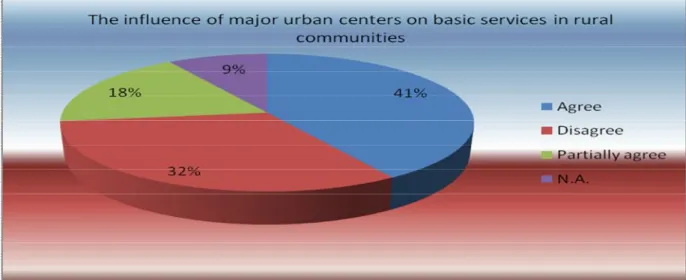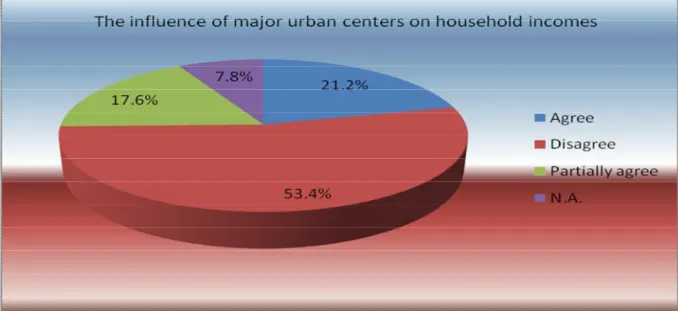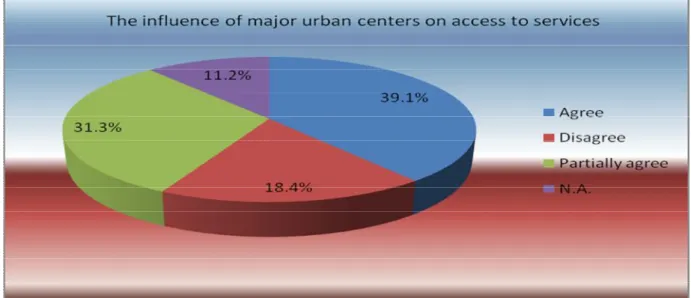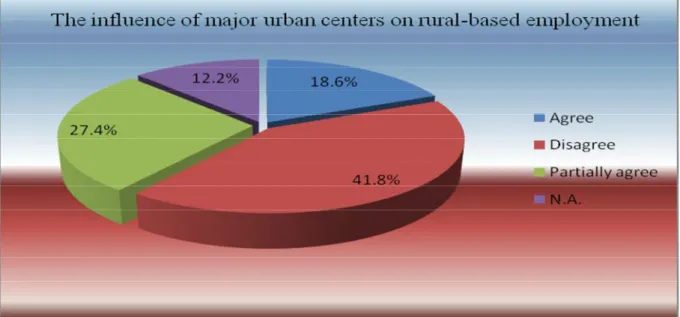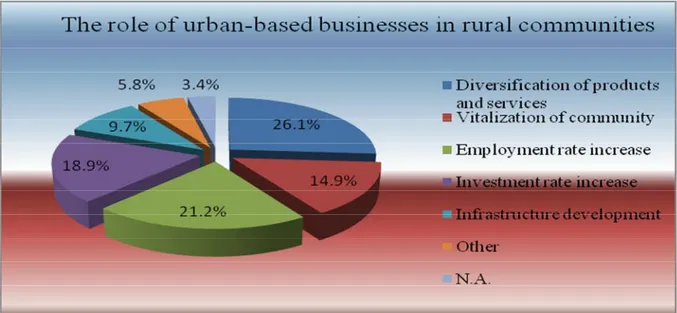AAB BIOFLUX
Advances in Agriculture & Botanics-
International Journal of the Bioflux Society
The analysis of the effects of rurbanization on
rural communities in the North-East Development
of Romania
Codrin Paveliuc-Olariu
Faculty of Agriculture, „Ion Ionescu de la Brad” University of Agricultural Sciences and Veterinary Medicine, Iaşi, Romania, EU. E –mail: codrin.po@gmail.com
Abstract. This paper highlights the effects of the rurbanization phenomenon on rural communities in the
North-East Development Region of Romania The paper summarizes the results of field research conducted in the Jijia – Bahlui Depression who have studied access to services, the rural – urban migration flow, the rural infrastructure status in the researched area as well as the influence of the urban centers proximity. The research has been achieved utilizing the direct inquiry method in three representative rural communities in the researched area, supplemented, in advance, by a research in national and international databases (ex. INS, FAOSTAT, EUROSTAT), as well as the utilization of official documents.
Key Words: rurbanization, interaction, development, strategy, migration pattern, positive, negative. Rezumat. Această lucrare evidenţiază efectele fenomenului de rurbanizare asupra comunităţilor rurale
din Regiunea de Dezvoltare Nord-Est a României. Lucrarea sintetizează rezultatele cercetărilor de teren efectuate în Depresiunea Jijia – Bahlui care au luat în studiu accesul la servicii, fluxul migratoriu rural – urban, starea infrastructurii în mediul rural din arealul cercetat, precum şi influenţa proximităţii centrelor urbane. Cercetările au fost realizate utilizându-se metoda anchetei directe în trei comunităţi rurale reprezentative din arealul cercetat, suplimentate de o cercetare, în prealabil, în baze de date statistice naţionale şi internaţionale (ex. INS, FAOSTAT, EUROSTAT), precum şi utilizarea documentelor oficiale.
Cuvinte cheie: rurbanizare, interacţiune, dezvoltare, strategie, model migratoriu, pozitiv, negativ.
Introduction. The rurbanization was first recorded in the French National Population
Census of 1982, a population growth phenomenon being observed in rural migration to the effect of changing the rural – urban migration direction to urban – rural (Chapuis & Brossard 1989). This phenomenon was explained using the term „rural rebirth” which presents the following determining elements: „community policies, receptivity, land usage, utilizing neighbors, agricultural development, tourist sites, secondary residences, available homes, endless options” (Banon 1980; Barbichon 1977; Bauer 1977; Borras 2009; Boyer 1980). This term explains the migratory flow caused by the effects of rurbanization, but it does not encase its full effects, positive and negative, on rural livelihoods. A definition of the rurbanization phenomenon presents its effect on rural patterns: ”
r
urbanization is a process of altering rural forms with pre-selected urban patterns and lifestyles, which creates new genetically altered rurban forms” (Kayser 1990; Mahajan 2010).A Europe Commission study realized a classification of rural spaces, taking into considerations the changes and tendencies observed in the European rural area, starting from the rurbanization phenomenon principle and continuing with the main economic activities observed (Europe 2000). According to this classification, rural spaces in the Jijia – Bahlui Depression of the North-East Development Region of Romania are classified as:
1. Rural space in close proximity to major urban centers – characterized by: - A surplus of industrial, residential and recreation zones;
- High trade rate;
- Transport development (increased traffic and the development of road infrastructure).
2. Rural space utilized for tourism – characterized by: - Reduced agricultural activities;
- Population growth; - Habitat fragmentation;
3. Rural space with activities diversification – characterized by: - High dependency to agriculture;
- The development of complementary activities;
4. Rural space predominantly agricultural – characterized by: - Very efficient and productive agriculture;
- Low traditionalism;
5. Rural space in difficulty – characterized by: - Mountain areas;
- High rural – urban migration rates; - Areas inhabited by third age population.
Material and Method. In order to characterize the effects that rurbanization process
has on rural communities in the North-East Development Region of Romania, a field research was conducted in three representative villages in the Iaşi and Botoşani counties. A direct survey based on one–on–one interviews was realized (Mougenot 1982; Ramesh 2009; Neto & Weliwita 2008; Sanders 1999). The quota sampling was used which consists in dividing the researched population in quotas, indicating the frequency of the individuals that present the same characteristics in a given area (Schmidt-Kallert 2009; Thurlow 2009). This procedure limits the operator subjectivity, prescribing framing those choices in certain quotas (Sivakumar & Sundaravaradarajan 2008). For the Mirceşti, Belceşti villages of the Iaşi County and Vorona village of the Botoşani County, the main characteristics searched by the field researcher were age, level of studies, income level per household and per person, type and level of expenses per household and per person, access to services and infrastructure. The sampling basin was represented by a total population of 26.027 persons of which a representative sample of 10% was tested. In addition, in the Belceşti village, a monitorization of the rural – urban migration flow was started in February 2009 with the sole objective to monitor the influence that the proximity of Iasi city holds on the population growth/decrease of Belcesti village. The research has been carried out in the 01.2009 – 12.2009 period.
Results and Discussion. Following the field research, a series of results regarding the
interactions, both positive and negative, between rural communities in the North-East Development Region of Romania and major urban centers have emerged.
The positive rural – urban interactions that have been identified took into account accessibility to arable land and agricultural capital, access to local and regional markets, diversification of livelihoods, increased employment opportunities and others.
When asked about the effect of the proximity of urban centers on the quality of basic services in the village (water, sewage, electricity), 41% of the respondents agreed that when a major urban centers is a distance no more than 15 kilometers, basic services are improved with over 50%. 18% of the respondents partially agreed while 32% disagreed stating that basic services did not improve due to the closeness of major urban services. 9% of respondents chose not to answer (see Figure 1).
Figure 1. Influence of major urban centers on basic services in rural communities. To the question “Does the proximity of a major urban center influence the level and type of expenses in your household? (see Figure 2), 29.7% of total respondents stated that no diversification in the type or level of expenses has been registered over the past year (01.09 – 12.09) due to the influence of relevant urban centers in close proximity with the village. An increase of 2.78% in household expenses was registered for this group over the past year, irrelevant for the present research. 36.5% of total respondents fully agreed that major urban centers in close proximity with the village give more options to products and services and, such, a diversification in the type and level of expenses per household and person is registered. An increase in expenses per household for this group over the past year (01.09 – 12.09) of 19.71% was registered. 12.0% of total respondents chose not to answer to this question.
Figure 2. Influence of major urban centers on the type and level of household expenses in rural communities.
The influence of major urban centers on the type and level of household incomes has been noted as being insignificant. Due to the rural – urban migration flow, 21.2% of total respondents stated that the level and type of incomes have improved due to the
been registered. Yet, 53.4% of total respondents identified the influence of major urban centers on household incomes as being negative, due to the fact that a decrease of 9.23% in the level of incomes per household has been registered over the past year (01.09 – 12.09).
7.8% of total respondents chose not to answer this question (see Figure 3).
Figure 3. Influence of major urban centers on the type and level of household incomes in rural communities.
The rurbanization phenomenon is known by rural development specialist through the flows created as rural and urban centers interact. Four types of flows have been identified in the North-East Development Region of Romania:
- Population flow – between rural and urban communities, based on a “shuttle”
concept on a regular basis, for occasional visits, for the utilization of urban services or temporary/permanent migration;
- Services flow – characterized by the transfer of urban-based services to rural
communities;
- Information flow – between rural and rural which include information regarding
the market mechanisms – from market fluctuations to consumer preferences – to information about possible employment for potential “rural migrants”; - Financial flows – which include, especially, transfers from “rural migrants” to
relatives from home communities, as well as official transfers such as pensions and unemployment aid of urban – rural migrants. The financial flows also include investments and credits given to persons and enterprises in rural space by urban based financial institutions.
In regards with this classification, in the Jijia – Bahlui Depression of the North-East Development Region of Romania, an increase of 14.56% in the rural population access to urban-based services has been identified. This is mainly due to the population flow which increased over the past year (01.09 – 12.09) with 11.2%. The increase of the rural – urban population flow is created by the lack of basic services in rural communities (ex. access to quality medical and educational services) and a decrease in rural employment caused by the global financial crisis. These factors complemented by a decreased access to land and agricultural equipment and capital, caused a massive migratory flow to major urban centers as a temporary solution.
When asked if major urban centers influences the access to services, 39.1% of total respondents agreed that the proximity to a major urban center increased the access to rural population to basic services (ex. medical services, education) by approximately
17.5% over the past year (01.09 – 12.09) while, in the case of 31.3% of total respondents that partially agreed with this response, the access to basic services did not increase significantly, a percentage of 4.2% being registered.
18.4% of total respondents registered a decrease of – 2.32% in the quality and/or access to basic services over the past year (01.09 – 12.09) caused by poor infrastructure, financial difficulties etc. 11.2% of total respondents chose not to answer to this question (see Figure 4).
Figure 4. Influence of major urban centers on access to services for rural inhabitants. The influence of the rurbanization phenomenon is shown also by an increase in the rate of rural-based employment and that of rural – urban migration flow on a “shuttle” basis caused by urban employment for rural inhabitants.
In the 01.09 – 12.09 periods, an increase of 23.1% in the rural – urban migration flow was observed for the researched area. 48.9% of total respondents stated that they know between 1 – 5 persons that shuttle to an urban city on a daily basis for work. 32.6% of total respondents may know 1 person that shuttle to an urban center for work while 11.2% know more than 5 persons that do so.
Due to the proximity of rural communities to urban centers, urban – based enterprises moved their services in the countryside because of lower land taxes, local taxes or subsidies awarded to rural enterprises. This urban – rural flow caused an increase of rural-based employment rate over the past year in non-agricultural activities, many of these requiring specialized labors. In 2009, a number of 7 urban-based businesses started branches in Mirceşti village and 12 new enterprises were initiated. In the Belceşti village, 6 urban-based businesses where relocated or have started branches and 11 new business with non-agricultural activities were initiated. In Botoşani County, in the Vorona village, 2 urban-based businesses started branches while 5 new enterprises with non-agricultural activities were initiated.
Figure 6. Influence of major urban centers on rural-based employment.
Rural-based employment due to the relocation or opening of branches of urban-based businesses is not seen as a developmental factor for the rural community through an increase rate of employment. Most time, this kind of businesses don`t create workplace for rural inhabitants, requiring only specialized personnel. 41.8% of total respondents disagreed when asked about the role that urban-based businesses relocated in rural communities play in rural employment. They stated that “this kind of businesses don`t hire peasants. We only know how to grow plants and animals, not to work with computers and stuff.” 18.6% of total respondents argued that urban-based businesses relocated in the rural space definitely create more workplace, directly or indirectly (“by investments created by others brought after”). 12.2% of total respondents chose not to answer to this question.
When asked about the role than urban-based enterprises hold in rural communities, 26.1% stated that they bring a diversification in the range of products and services available to rural inhabitants, 14.9% said that they have a vitalizing role in the community, representing a development factor while 21.2% of total respondents considered that they have a major role in increasing the employment rate. 18.9% of total respondents stated that the establishment of urban-based businesses in rural communities will increase the investment rate in these villages while 9.7% agreed that there will be a significant difference in the development of rural infrastructure after urban-based enterprises are established in rural areas. 5.8% of total respondents chose another option when asked about the role of urban-based businesses in rural communities while 3.4% chose not to answer to this question.
Figure 6. The role of urban-based businesses in rural communities.
As you can see, rurbanization is a slow process with significant influences on rural areas. This slow change rate can be observed on three levels: local, regional and national. a) At local level, modifications are easy to identify, measure and compare. These can be notice in the increase of crop yields, diversification of products and services for rural inhabitants and others. The financing availability, technologies, inputs knowledge’s, insurance facilities help create socio-economic growth models in the durable rural development process;
b) At regional level, the changes caused or due by rurbanization take place in different rural communities of the region, connecting afterwards and forming strong regional bonds. Some regions have been identified as coordinated regional development models. Such is the case of the North-East Development Region in which inter-regional movements are strengthened while new links are established. Regional migration patterns in these regions are constantly changing with great variation.
c) At national level, the effect of rurbanization are shown by the rural-urban migration process which, after the need of the rural population to migrate to urban areas for urban-based services and employment is reduced, in some cases, can be reversed. The economic flow can also be affected by the rurbanization process at national level.
Conclusions. As shown, the rurbanization phenomenon influences rural communities
both positive and negative. In the direct inquiry conducted in the 01.09 – 12.09 period in the Belcesti and Mirceşti villages of Iaşi County and Vorona village of Botoşani County located in the North-East Development Region of Romania, a total number of questionnaires 2609 were applied of which 211 were cancelled because of incorrect completion procedure that could have lead to the invalidation of results. The quota procedure was used for setting up the sampling basin.
The rurbanization process classifies rural spaces in five different types: rural space in close proximity to major urban centers, rural space utilized for tourism, rural space with activities diversification, rural space predominantly agricultural and rural space in difficulty. This classification is based on the proximity of rural communities to major urban centers and their influence on rural economic activity.
The influence of the rurbanization process on rural communities is shown by the effect it holds on the type and level of expenses and incomes per rural household, 36.5% of the interviews population registering an increase in the level and type of expenses with 19.71% while 21.2% of the respondents registered an increase of 12.36% in the level and type of incomes due to the influence of major urban centers in close proximity.
Another positive aspect of rurbanization is that of the relocation of urban-based enterprises in rural communities either by moving their headquarters or by opening branches. 14.9% of total respondents considered urban-based businesses moving to their villages as being a development factor who is able to vitalize the community, by increasing the employment rate (21.2% of total respondents), increasing the investments made in the community by public or private institutions (18.9%) or by simply diversifying the range of products and services available to rural inhabitants (26.1%).
References
Banon M., 1980 The rural environment. Economie et Finances Agricoles 1980:63-68. Barbichon G., 1977 Industry and rurbanization: sociological aspects. Economie Rurale
117:28-34.
Bauer G., 1977 Suburban countryside, spreading towns: how much is known of the "rurban" phenomenon? Economie Rurale 117:13-16.
Borras S. M. Jr., 2009 Special Issue: Critical perspectives in agrarian change and peasant studies. Journal of Peasant Studies 36(1):5-265.
Boyer J. C., 1980 Second homes and "rurbanization" in the Paris region. Tijdschrift voor Economische en Sociale Geografie 71(2):78-87.
Chapuis R., Brossard T., 1989 The demographic evolution of rural France (1968-1982). Journal of Rural Studies 5(4):357-365.
Europe, 2000 1994 Co-operation for European Territorial Development, 1994.
Kayser B., 1990 [The rural renaissance. Sociology of campaigns in the western world]. Armand Colin, Paris, pg.68. [In French]
Mahajan S., 2010 Rurbanization. Document available online at: http://sdmahajan.tripod.com/rurbanization.htm
Mougenot C., 1982 The social mechanisms of "rurbanization". Sociologia Ruralis
22(3/4):264-278.
Neto F., Weliwita A., 2008 Working for rural-urban linkages - small and medium-size enterprises. Habitat Debate 14(2):14-15.
Ramesh C., Raju S. S., Pandey L. M., Surabhi S., 2009 Linkages between urban consumption and rural non-farm employment and agricultural income: a new perspective. Indian Journal of Agricultural Economics 64(3):409-420.
Sanders S., 1999 Growth management and farmland: the state policy context. In: California farmland and urban pressures: statewide and regional perspectives, Pp 71-88.
Schmidt-Kallert E., 2009 A New Paradigm of Urban Transition: Tracing the Livelihood Strategies of Multi-Locational Households. ERDE 140(3 Sp Iss):319-336.
Sivakumar P., Sundaravaradarajan K. R., 2008 Agricultural labor migration
vis-a-vis rural-urban linkages. Agriculture Update 3(1/2):111-114.
Thurlow J., Morley S., Pratt A. N., 2009 Lagging regions and development strategies. IFPRI - Discussion Papers 898:vi-27.
Received: 18 February 2010. Accepted: 29 April 2010. Published: 29 April 2010. Author:
Codrin Paveliuc-Olariu, Department of Economic and Humanist Sciences, Faculty of Agriculture, “Ion Ionescu de la Brad” University of Agricultural Sciences and Veterinary Medicine Iaşi, 3rd
Aleea M. Sadoveanu, Iaşi 700490, Romania, EU, e-mail: codrin.po@gmail.com
How to cite this article:
Paveliuc-Olariu C., 2010 The analysis of the effects of rurbanization on rural communities in the North-East Development of Romania. AAB Bioflux 2(1):41-48.
